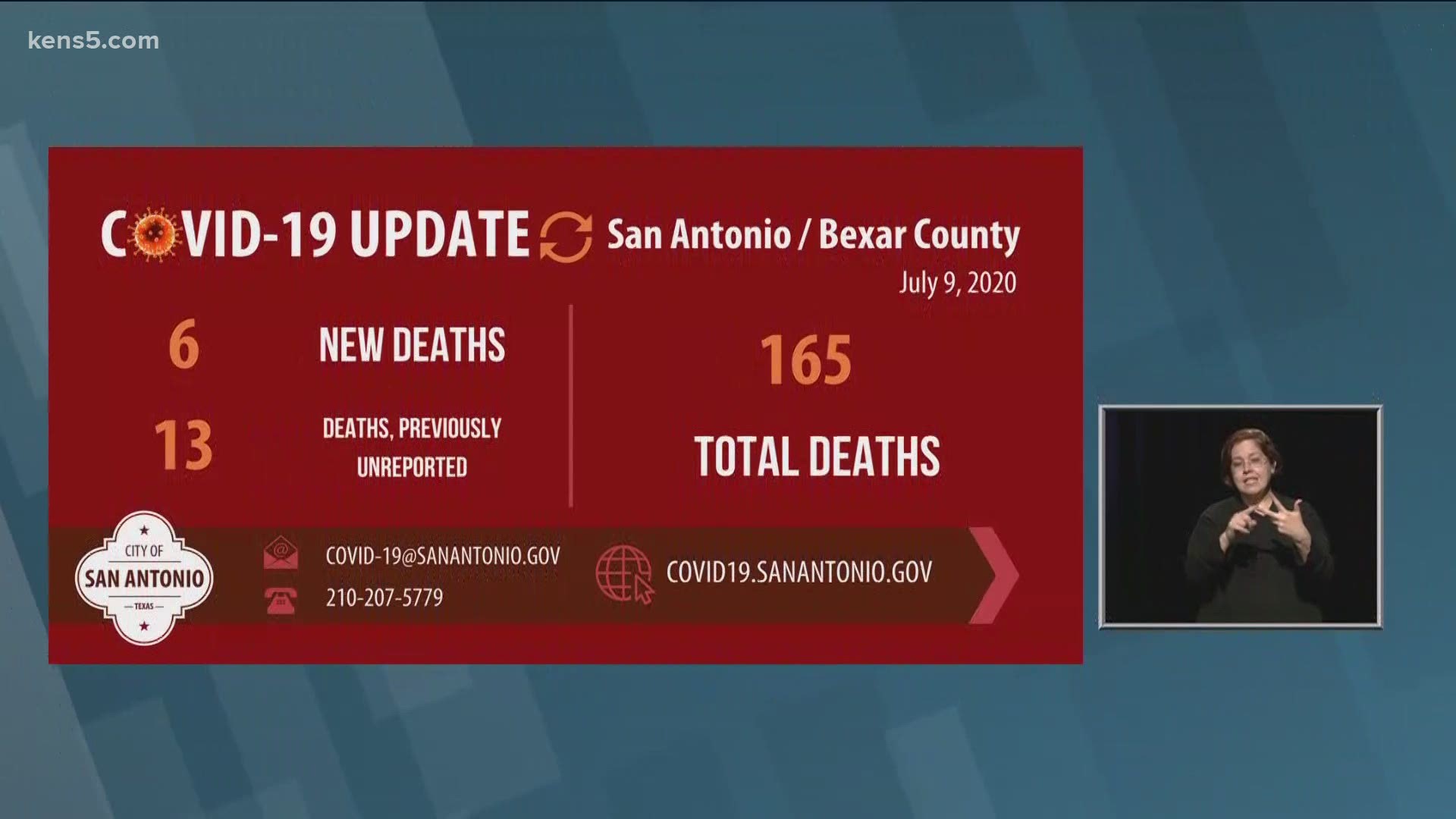SAN ANTONIO — We're tracking the latest numbers from the coronavirus pandemic in San Antonio and across Texas. Here are the latest numbers reported by Bexar and surrounding counties:
- Bexar County: 954 new cases and 19 fatalities from COVID-19 were reported Thursday. There have been a total of 17,679 cases and 165 virus-related fatalities in the county.
- Comal County: Comal County reported 103 new cases of coronavirus Thursday morning (bringing the total to 1,245) and three new COVID-19 related deaths. 21 people have now died in the county, while 386 have recovered. The positivity rate 14.75%, up from Thursday and 12.67% one week ago.
- Hays County: The county reported 92 new lab-confirmed coronavirus cases Friday. As of July 10, the Hays County Local Health Department confirms a total of 3,501 cases in the county, 2,835 of which remain active. The county's death toll is 11. 69 Hays County residents in total have been hospitalized with COVID-19, and 20 are still in the hospital.
Bexar County reports the full numbers daily at 7 p.m.
How Bexar County is trending:
We're tracking how many coronavirus cases are confirmed in Bexar County each day from the time San Antonio Metro Health began reporting cases more than two months ago. Graphing those daily case numbers along a 14-day moving average provides an accurate picture of the curve in the San Antonio area and the direction we're heading amid the coronavirus.
On Thursday, Mayor Ron Nirenberg reported 954 newly confirmed cases of coronavirus in Bexar County. The total number of cases in the San Antonio area now sits at 17,679. There are 11,332 active cases in the county, while 6,182 residents have recovered.
Additionally, the mayor reported 19 fatalities related to COVID-19. In explaining the steep jump in deaths, Nirenberg explained that 6 deaths classified as new fatalities, while 13 deaths were "previously unreported."
Nirenberg said these previously unreported deaths were part of a post-mortem investigation conducted by city health officials. If a recently-deceased San Antonio resident exhibited symptoms of coronavirus but was not tested before their death, the team will conduct a COVID death. These thirteen fatalities were discovered within the last three weeks, Nirenberg said.

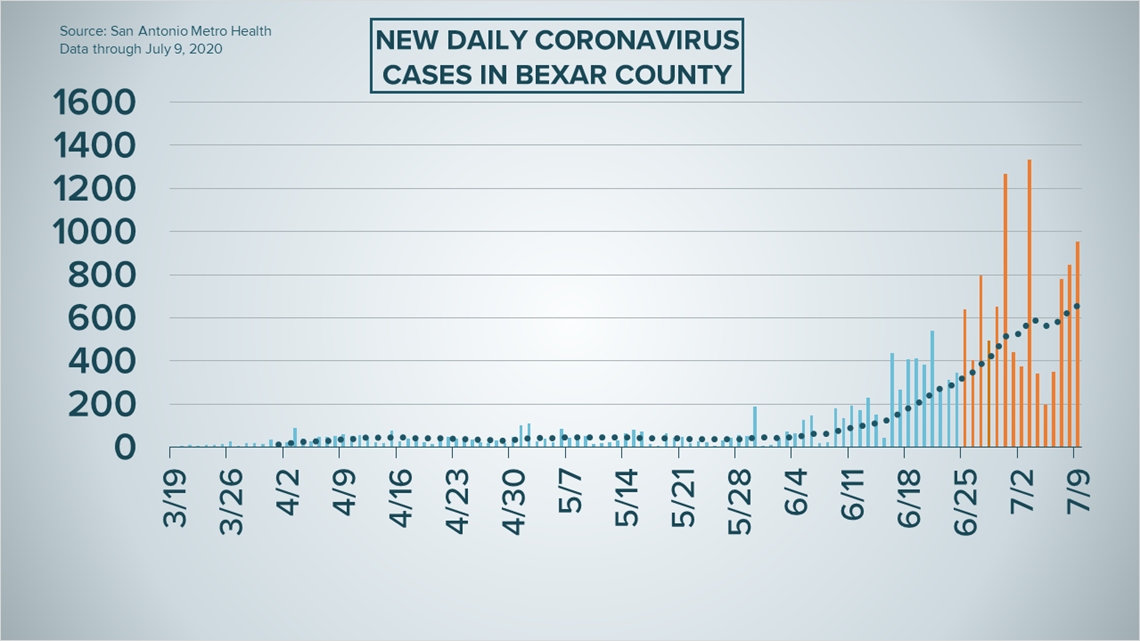
Hospital capacity rose to 1,216 Thursday, while the number of patients in ICU remained at 399. 231 patients are on ventilators. 11 percent of local hospital beds are available, while 45 percent of the city's ventilators are available.

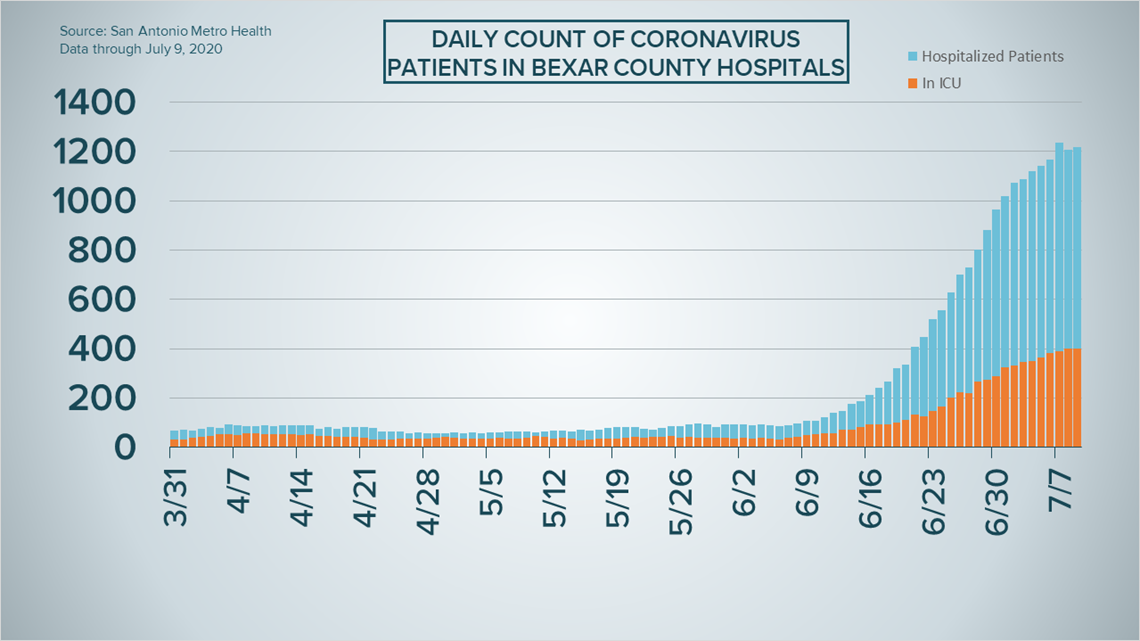
Coronavirus in Texas
State officials reported 105 new fatalities Thursday; it's the second day in a row where the state recorded a new high mark for COVID deaths in a 24 hour period. A total of 2,918 Texans have died from coronavirus, as of Thursday.

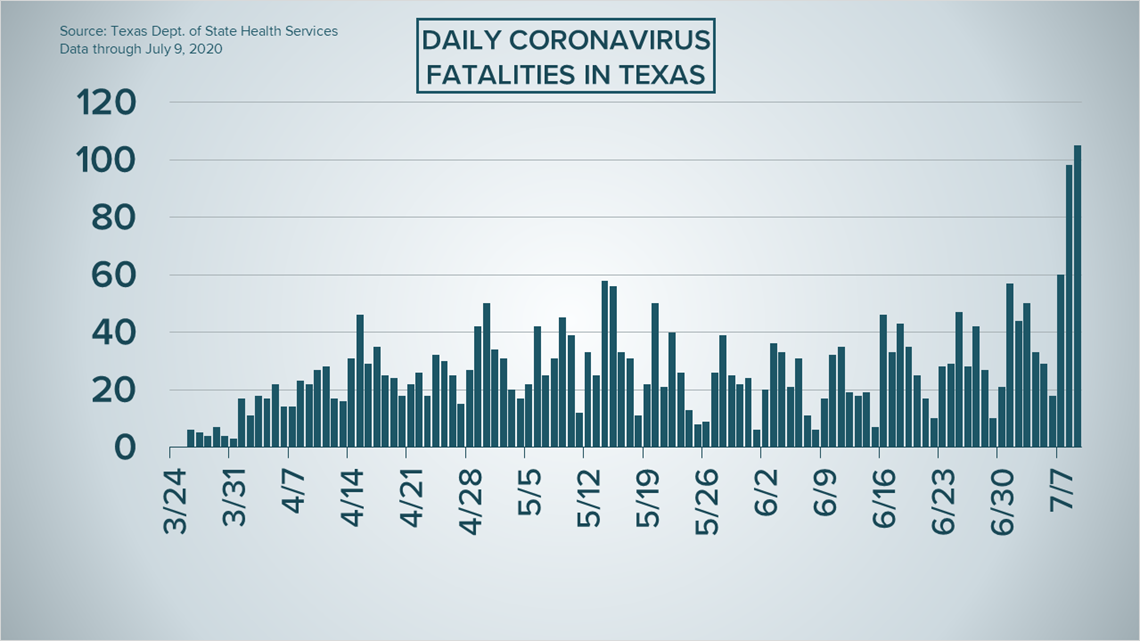

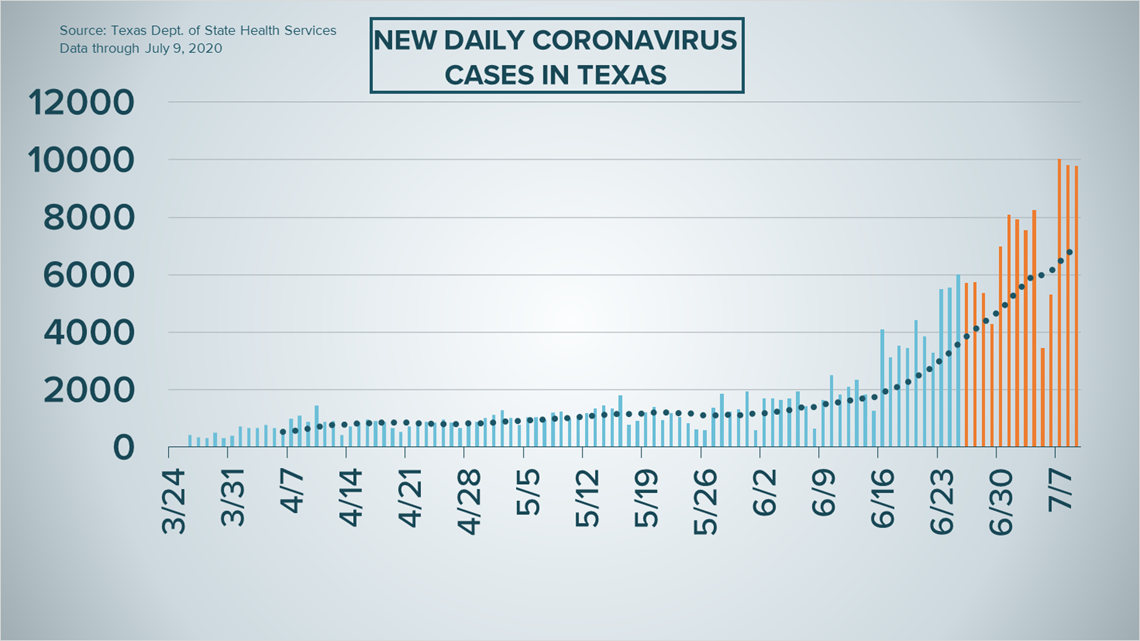
The number of total coronavirus cases in Texas grew by 9,782 Thursday; a total of 230,346 Texans have tested positive for coronavirus since the pandemic began earlier this year.
Nearly 10,000 Texans remain hospitalized with coronavirus as the dwindling hospital capacity across the state remains a major concern. Less than 1,000 of the 8,724 ICU beds across the state are available; in two weeks, the number of Texans in ICU has doubled.

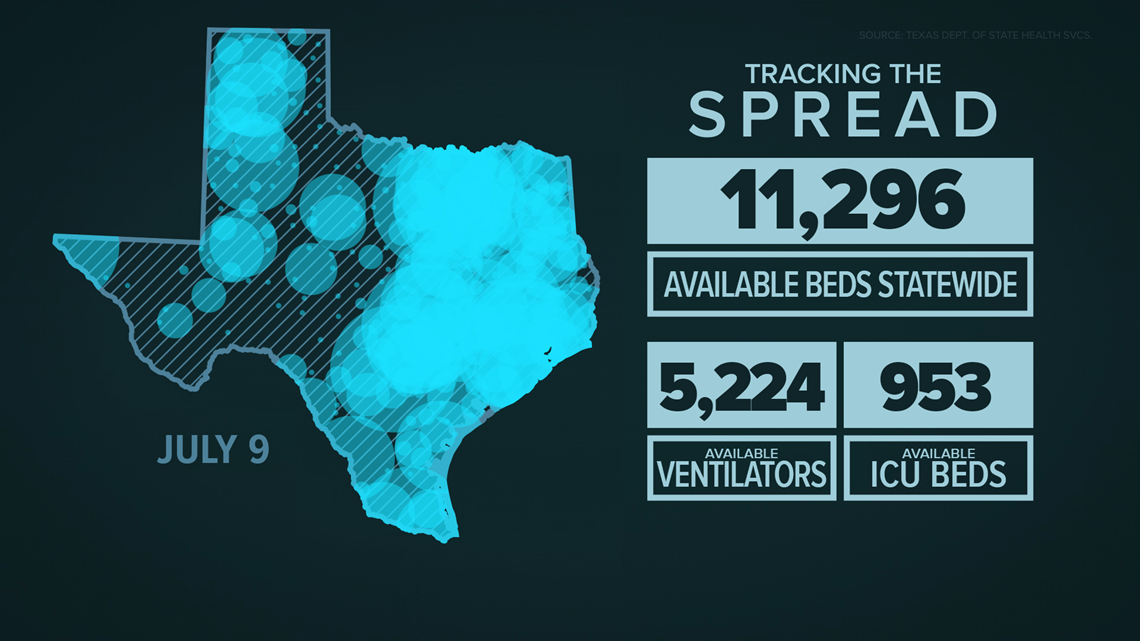
Latest Coronavirus Headlines
- Some experts say it's likely COVID-19 is airborne. Here's how containment could change.
- Local photographer to offer free professional headshots to unemployed
- San Antonio congressmen urge Pentagon to allow BAMC to treat coronavirus patients
- Number of Texans filing unemployment claims increased for second week in a row as 117,244 sought benefits
- CDC: Guidelines for reopening schools aren't being rewritten
- Lawyer: TSA makes changes after whistleblower's complaint
Coronavirus symptoms
The symptoms of coronavirus can be similar to the flu or a bad cold. Symptoms include fever or chills, cough, shortness of breath or difficulty breathing, fatigue, muscle or body aches, headache, new loss of taste or smell sore throat, congestion or runny nose, nausea or vomiting and diarrhea, according to the Centers for Disease Control.
Most healthy people will have mild symptoms. A study of more than 72,000 patients by the Centers for Disease Control in China showed 80 percent of the cases there were mild.
But infections can cause pneumonia, severe acute respiratory syndrome, kidney failure, and even death, according to the World Health Organization. Older people with underlying health conditions are most at risk.
On June 25, the CDC expanded the list of groups at a higher risk of severe illness due to coronavirus.
Experts determined there was consistent evidence these conditions increase a person's risk, regardless of age:
- Chronic kidney disease
- COPD (chronic obstructive pulmonary disease)
- Obesity (BMI of 30 or higher)
- Immunocompromised state (weakened immune system) from solid organ transplant
- Serious heart conditions, such as heart failure, coronary artery disease, or cardiomyopathies
- Sickle cell disease
- Type 2 diabetes
The CDC believes symptoms may appear anywhere from two to 14 days after being exposed.
Human coronaviruses are usually spread...
- Between people who are in close contact with one another (within about 6 feet).
- Through respiratory droplets produced when an infected person coughs, sneezes or talks. These droplets can land in the mouths or noses of people who are nearby or possibly be inhaled into the lungs.
- Some recent studies have suggested that COVID-19 may be spread by people who are not showing symptoms.
Help stop the spread of coronavirus
- Stay home when you are sick.
- Eat and sleep separately from your family members
- Use different utensils and dishes
- Cover your cough or sneeze with your arm, not your hand.
- If you use a tissue, throw it in the trash.
Lower your risk
- Wash your hands often with soap and water for at least 20 seconds. If soap and water are not available, use an alcohol-based hand sanitizer.
- Avoid touching your eyes, nose, and mouth with unwashed hands.
- Avoid close contact with people who are sick.
- Clean and disinfect frequently touched objects and surfaces.
- The CDC recommends wearing a mask or cloth face covering if you have to be out due to an essential service or essential activity such as going to the grocery store.
- If you are 60 or over and have an underlying health condition such as cardiovascular disease, diabetes or respiratory illnesses like asthma or COPD, the World Health Organization advises you to try to avoid crowds or places where you might interact with people who are sick.

